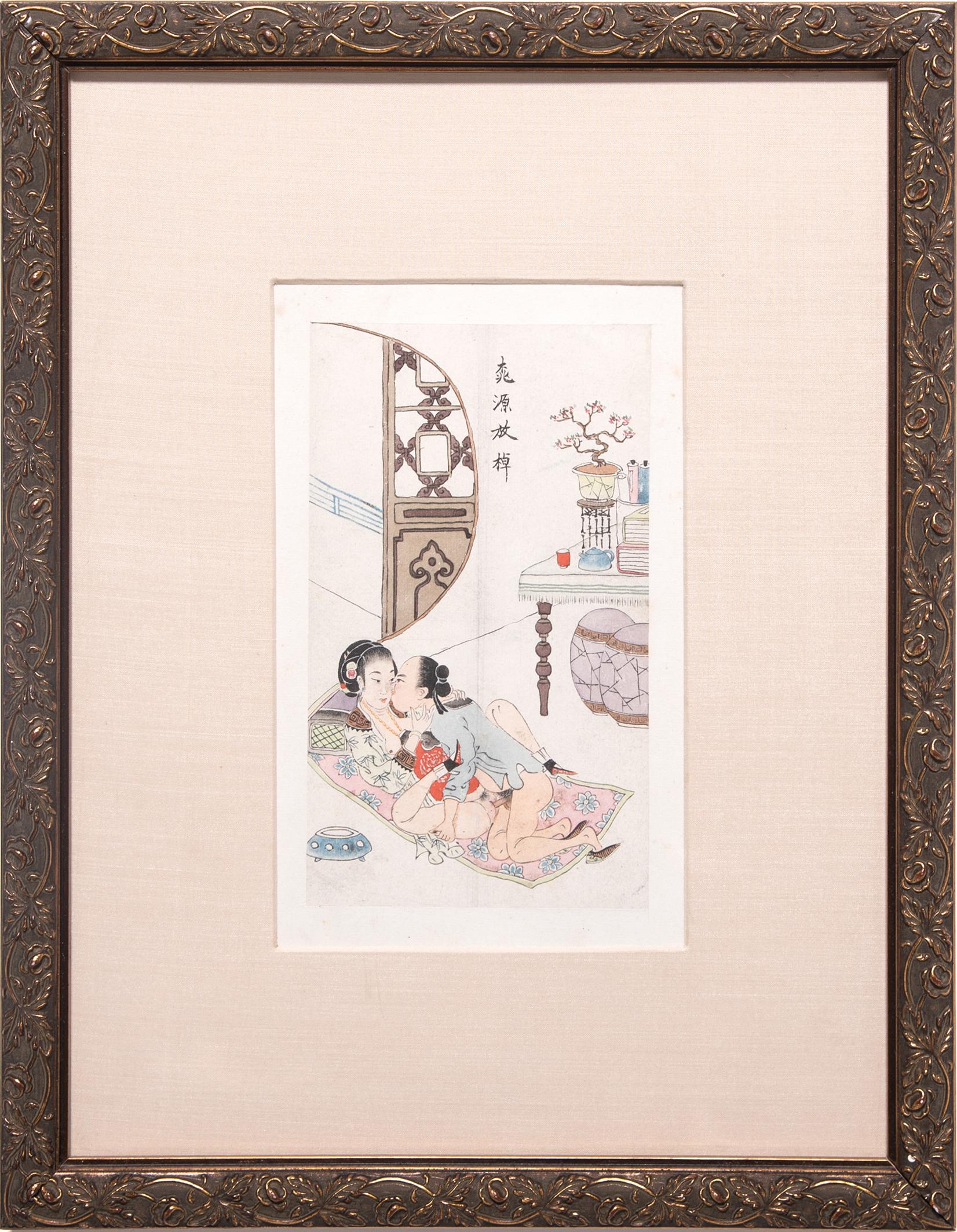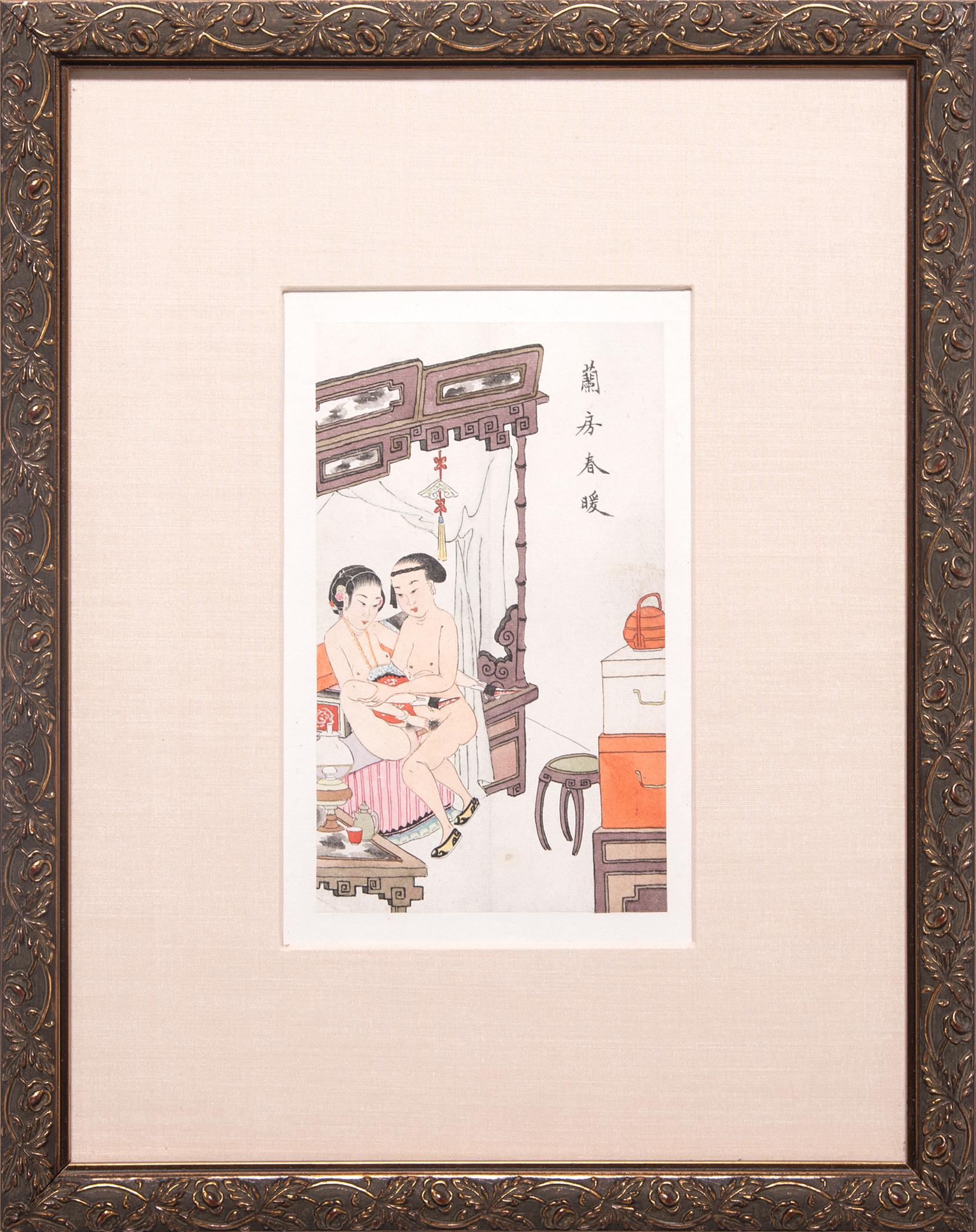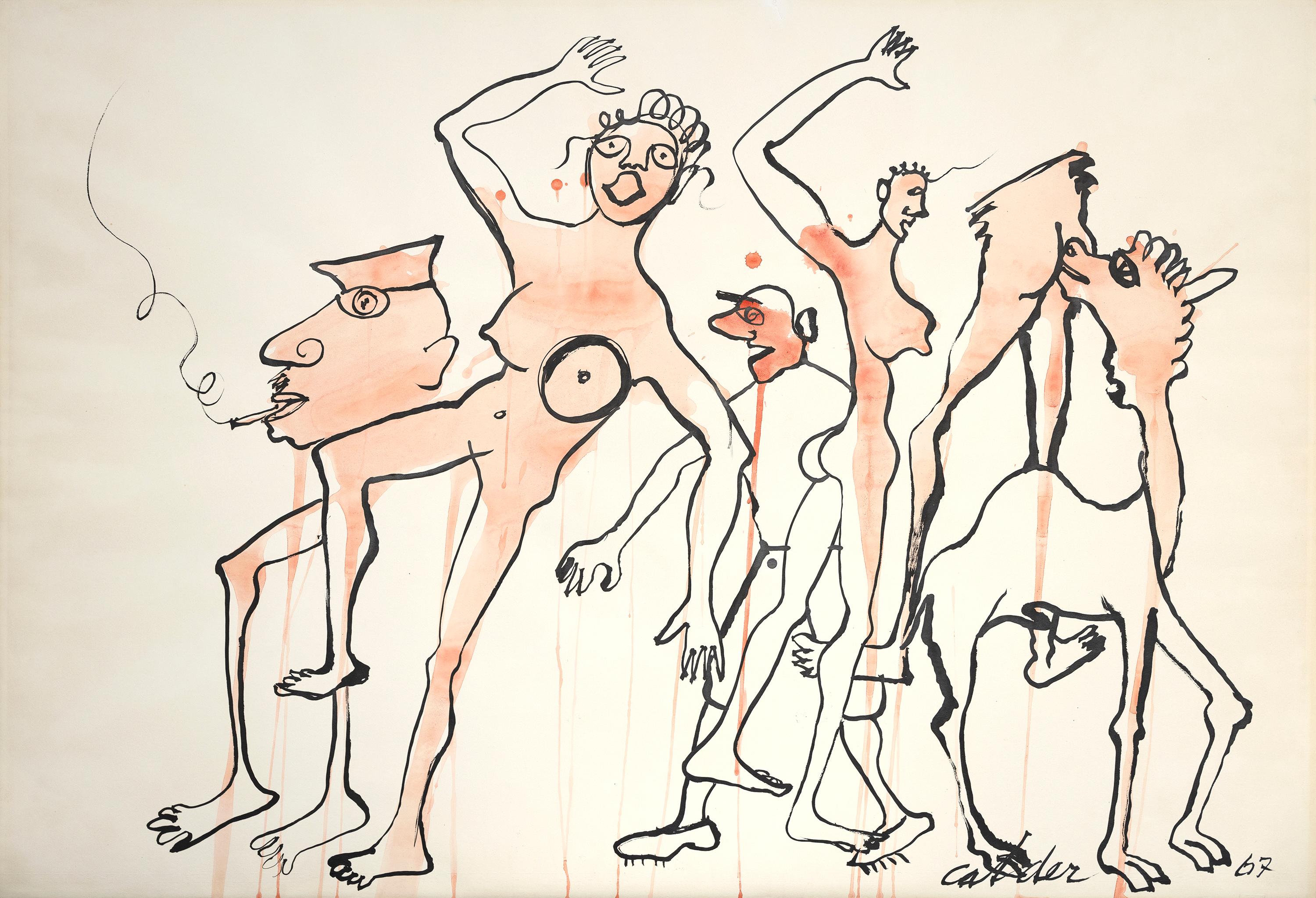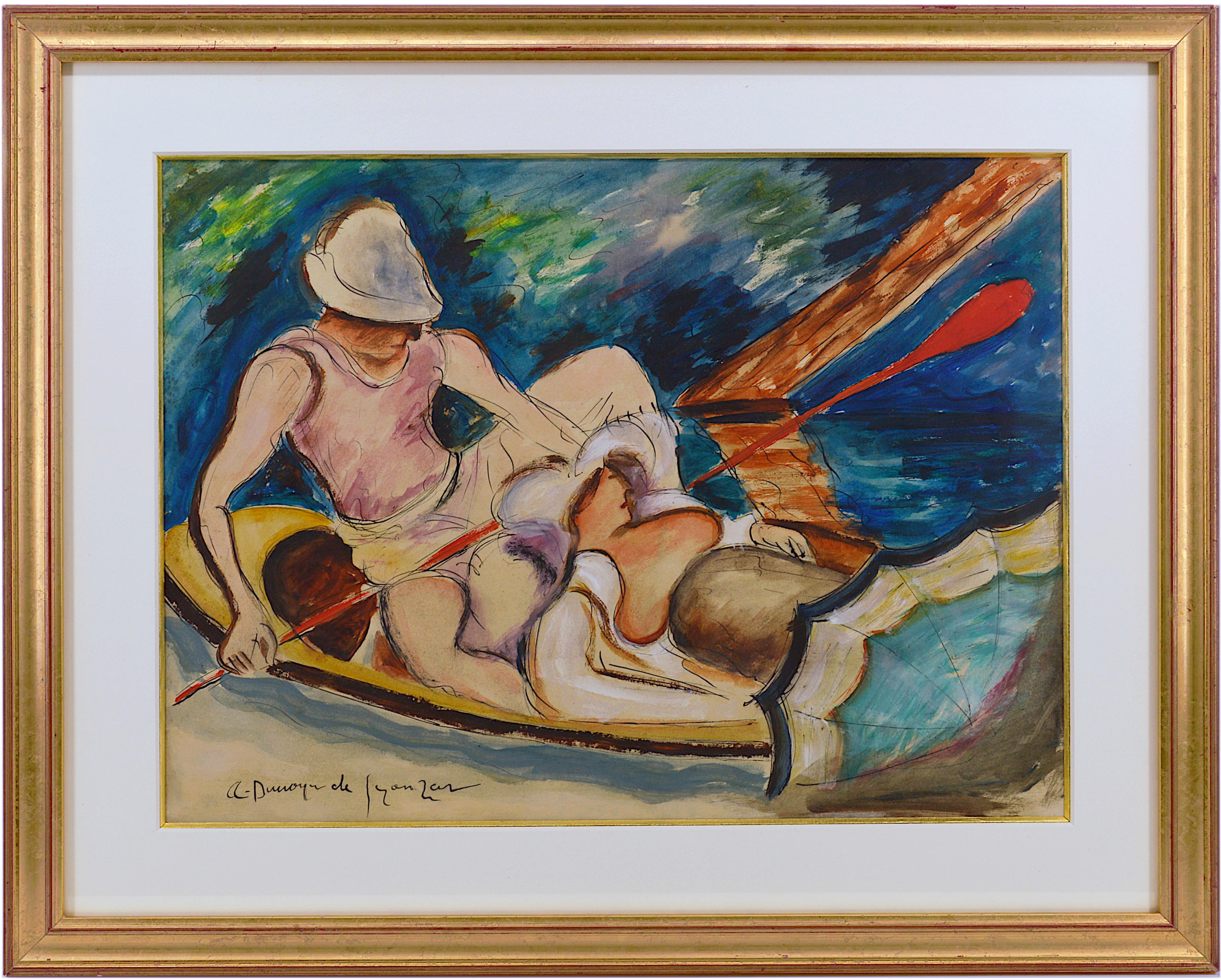Items Similar to Chinese Erotic Album Leaf, c. 1850
Want more images or videos?
Request additional images or videos from the seller
1 of 9
UnknownChinese Erotic Album Leaf, c. 1850c. 1850
c. 1850
About the Item
Despite its explicit content, this intimate scene conveys a sense of tenderness and romantic love characteristic of Chinese erotic art. Known as “spring palace paintings,” these ink and watercolor illustrations imagined the sensual delights of courtly life. Taken from an album of erotic paintings, this framed leaf departs from a tradition of depicting lovers in risqué outdoor settings by picturing an amorous coupling in a distinctly Qing-dynasty interior. The uniquely detailed surroundings shed light on the prevailing aesthetic tastes in decor and furniture of 19th-century China. Note the wooden stool, lacquered headrest pillow, and grand canopy bed, carved with ruyi-form and key-pattern motifs.
- Creation Year:c. 1850
- Dimensions:Height: 14.75 in (37.47 cm)Width: 11.75 in (29.85 cm)Depth: 1 in (2.54 cm)
- Medium:
- Movement & Style:
- Period:
- Condition:
- Gallery Location:Chicago, IL
- Reference Number:
About the Seller
5.0
Diamond Seller
These expertly vetted sellers are 1stDibs' most experienced sellers and are rated highest by our customers.
1stDibs seller since 2018
25 sales on 1stDibs
- ShippingRetrieving quote...Ships From: Chicago, IL
- Return PolicyA return for this item may be initiated within 2 days of delivery.
More From This SellerView All
- Chinese Erotic Album Leaf, c. 1850Located in Chicago, ILDespite its explicit content, this intimate scene conveys a sense of tenderness and romantic love characteristic of Chinese erotic art. Known as “sp...Category
Mid-19th Century Qing Figurative Drawings and Watercolors
MaterialsInk, Watercolor, Paper
- Chinese Erotic Album Leaf, c. 1850Located in Chicago, ILDespite its explicit content, this intimate scene conveys a sense of tenderness and romantic love characteristic of Chinese erotic art. Known as “sp...Category
Mid-19th Century Qing Figurative Drawings and Watercolors
MaterialsPaper, Ink, Watercolor
- Chinese Erotic Album Leaf, c. 1850Located in Chicago, ILDespite its explicit content, this intimate scene conveys a sense of tenderness and romantic love characteristic of Chinese erotic art. Known as “spring palace paintings,” these ink and watercolor illustrations imagined the sensual delights of courtly life. Taken from an album of erotic paintings, this framed leaf departs from a tradition of depicting lovers in risqué outdoor settings by picturing an amorous coupling in a distinctly Qing-dynasty interior. The uniquely detailed surroundings shed light on the prevailing aesthetic tastes in decor and furniture of 19th-century China. Note the carved wooden headrest, blue and white censer...Category
Mid-19th Century Qing Figurative Drawings and Watercolors
MaterialsPaper, Ink, Watercolor
- Chinese Erotic Album Leaf, c. 1850Located in Chicago, ILDespite its explicit content, this intimate scene conveys a sense of tenderness and romantic love characteristic of Chinese erotic art. Known as “sp...Category
Mid-19th Century Qing Figurative Drawings and Watercolors
MaterialsPaper, Ink, Watercolor
- Chinese Erotic Pillow Book Scroll, c. 1850Located in Chicago, ILA pillow book was meant to teach a young bride about the art of lovemaking. This rare museum-quality 19th century example is composed of 12 masterfully pai...Category
Mid-19th Century Qing Nude Drawings and Watercolors
MaterialsSilk, Paper, Watercolor
- "Hanging Scroll of Prunus Branches, " Ink on Paper, 1850Located in Chicago, ILChinese scholars used natural imagery and scenery to aid in contemplation within the walls of their studios. The complex beauty inherent to landscapes and natural forms inspired clea...Category
19th Century Qing Figurative Drawings and Watercolors
MaterialsPaper, Ink
You May Also Like
- PersonnagesBy Alexander CalderLocated in Palm Desert, CA"Personnages" is a gouache on paper by Alexander Calder. The work is signed in the lower right, "Calder 67". Although renowned for his innovative and groundbreaking sculptures, Alex...Category
1960s Figurative Drawings and Watercolors
MaterialsInk, Paper, Gouache
- "Boating on the Morin River"By André Dunoyer de SegonzacLocated in Saint Amans des cots, FRPen, ink, watercolor and wash on paper by André Dunoyer de Segonzac, France, 1922-1924. Boating on the Morin River. Measurements : with frame: 52.5x65x2 cm - 20.7x25.6x0.8 inches / without frame: 36.5x45 cm - 14.4x17.7 inches. Signed lower left "A. Dunoyer de Segonzac". Colors may vary slightly depending on your screen. The lighter band at the top and the bottom of the piece, visible in the first picture, is only due to the reflection in the protective glass. It does not exist. In its frame gilt with gold leaf and its protective glass. André Dunoyer de Segonzac was born in Boussy-Saint-Antoine (Essonne) July 7, 1884. After his schooling at high school Henri IV, as early as 1900, he attends classes at the National School of Fine Arts in Paris in free listener where he will befriend Charles Dufresne. In 1903, he enters the private studio of Luc-Olivier Merson. In 1907, he studies with Jean-Paul Laurens and attends the La Palette and Colarossi academies in Montparnasse. He meets Luc-Albert Moreau and Jean-Louis Boussingault with whom he shares a studio. His first drawings are published in 1908 in The Great Review and The Witness. Nearly indifferent to contemporary aesthetic revolutions, Dunoyer de Segonzac undertakes, with Jean-Louis Boussingault and Luc-Albert Moreau, to revive Gustave Courbet's realism by performing still lifes, nudes, landscapes, in a thick paste and masonry . In one of his letters to the painter Maurice Boitel, he wrote in the 1950s: "I have not forgotten the heroic period of the independents - when we were grouped around Paul Signac, the charming and valiant Maximilien Luce - in these barracks where the living and authentic Art was grouped outside the academic formulas - or literary and systematic tendencies - which were to lead to this abstract aesthetic of which the painting dies. " In 1908, he begins exhibiting at the Salon d'Automne and the Salon des Indépendants, with Paul Signac and Maximilien Luce. He befriends Apollinaire, Max Jacob, Raoul Dufy and Vlaminck. From this period, renting a house belonging to Signac, Dunoyer discovers the landscapes of Saint-Tropez, to which he will remain faithful and where he lived until the end of his life. He stays in Saint-Tropez only in the summer season. For the rest, he leads a real nomadic life, in search of the motive especially through the Île-de-France, the Grand Morin valley, Feucherolles, Chennevières-sur-Marne, Guyancourt, etc. "I also worked a lot on the banks of the Seine in Chatou, Bougival, Andrésy, Poissy and Triel that I particularly like, with its beautiful Gothic church that is reflected in the Seine and the high wooded hills that surround him", he will say. In 1910, he knows fashion designer Paul Poiret and meets Max Jacob, Raoul Dufy and Vlaminck. From 1910 to 1914, he travels to Italy, Spain, North Africa, and is interested in sport and dance (drawings of Isadora Duncan's Russian Ballets, 1911, The Boxers1910). From 1914 to 1918, mobilized in the infantry, he makes the war hardly, before being assigned to camouflage. He performs many war drawings, valuable for their artistic and documentary value. From 1919, he appears again in many exhibitions, including major Parisian salons. Nearly indifferent to contemporary aesthetic revolutions, Dunoyer de Segonzac undertakes, with Boussingault and Moreau, to revive Courbet's realism by performing still lifes, nudes, landscapes, in a thick and masonry paste. Enlisted in engraving by Jean Émile Laboureur, he makes nearly 1,600 brass plaques from 1919 to 1970. He was president of the Society of French painters-engravers. In 1921, he meets Paul Valéry, Léon-Paul Fargue and Jean Cocteau. In 1928, he makes a trip to America where he met with great success. In 1930, he becomes friend with Derain. In 1933 he receiveds the Carnegie Foundation of Pittsburgh Award and in 1934 the Venice Biennale. During the Occupation, in November 1941, he takes part in a "study trip" to Germany, organized by Arno Breker, accepting, like other artists of the most renowned, to visit the hotspots of German culture as well as artist workshops. After the war, he is exhibited in the best galleries...Category
1920s Realist Figurative Drawings and Watercolors
MaterialsPaper, Ink, Watercolor, Pen
- Original Art deco gouache and ink drawing of Jane Marnac in a hat by Gesmar 1921By Charles GesmarLocated in Petworth, West SussexCharles Gesmar (French, 1900 - 1928) Portrait of Jane Marnac, 1921 Gouache and ink on paper with some watercolour Signed ‘C. Gesmar. 21’ (upper left) 18 x 18 in. (45.8 x 45.8 cm.) Gesmar had a very short but successful artistic career prior to his tragic death from pneumonia. He designed for Mistinguett, creating costumes as well as many other commissions for the theatres of the day in Paris. He worked with posters and is thought of as a talent equal to Leon Bakst, his graphic designs linking the works of Toulouse Lautrec and Rene Grau...Category
Early 20th Century Art Deco Nude Drawings and Watercolors
MaterialsInk, Paper, Watercolor, Gouache
- Nude - Drawing by Mino Maccari - Mid 20th CenturyBy Mino MaccariLocated in Roma, ITNude is an original China Ink and Watercolour realized by Mino Maccari in mid-20th Century. Good condition on a yellowed paper. Hand-signed by the artist with pencil. Mino Maccari...Category
Mid-20th Century Modern Figurative Drawings and Watercolors
MaterialsInk, Watercolor, Paper
- Reclined Nude - Drawing by Mino Maccari - Mid 20th CenturyBy Mino MaccariLocated in Roma, ITReclined Nude is an original China Ink Drawing realized by Mino Maccari in mid-20th century. Good condition on a yellowed paper. Monogrammed by the artist with pencil. Mino Maccar...Category
Mid-20th Century Modern Figurative Drawings and Watercolors
MaterialsPaper, Ink, Watercolor
- Reclined Nude - Drawing by Mino Maccari - Mid 20th CenturyBy Mino MaccariLocated in Roma, ITReclined Nude is an original China Ink Drawing and Watercolour realized by Mino Maccari in mid-20th century. Good condition on a yellowed paper. Hand-signed by the artist with penc...Category
Mid-20th Century Modern Figurative Drawings and Watercolors
MaterialsPaper, Ink, Watercolor





